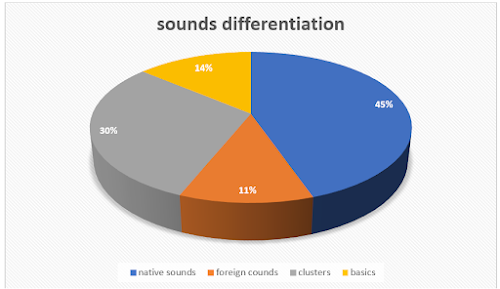Methodology in Language Learning: Juxtapositions of Sounds
At the early stages students need practice in hearing and saying the
sounds of isolated words as they are ideally pronounced by a native speaker,
without the distortions or blurs which commonly occur within the context of
natural speech. At this level, the listener's main problem is simply to
identify the right phoneme(s) and hence the right word.
The process of teaching them, therefore, is mostly based on a behaviorist
model. The teacher demonstrates the sounds she wishes to teach and encourages
students to imitate or identify them. When she feels they are hearing and
reproducing them with a fair degree of accuracy, she gives them a series of
tasks whose purpose it is simply to familiarize them with the new sounds to the
point where they can identify, if not pronounce, them accurately, easily and
without hesitation. It is important to remember that the object of such exercises is to train
not to test: if students are consistently getting wrong answers, the
teacher should stop, demonstrate again the sounds she wishes to teach, and make
sure her students have grasped them before continuing.
If students do not know the meaning of the words, they are more likely to
use their ears carefully, instead of guessing from what they think they 'ought'
to be. For example, I have had students understand 'pen' when I had said 'pan',
because they had learnt the meaning of the first item and not of the second. On
the other hand, this very mistake derives from a listening strategy we are
going to want to encourage- that is, guessing what something is likely
to be even if it has not been perceived properly.
Students with accurate aural perception can often reproduce sounds they hear without having the slightest idea what these mean. However, the more complex the material to be reproduced, the more difficult it is to repeat it accurately without understanding. For the purposes of this category of exercises, therefore, repetition should be based on short, easily memorized words. The teacher says, or plays on the tape recorder, a word or two, asks individual students to repeat them, and corrects where necessary. Having to imitate the sounds themselves helps learners to hear them correctly; but it must be remembered that mispronunciation does not necessarily imply that they are hearing them wrongly; students can often clearly perceive subtle distinctions they are incapable of reproducing themselves.
Repetition is rather time-consuming. It takes a long time to hear an
entire class repeat a single word, while most students are silent and
relatively inactive most of the time (in small classes, of course, this
objection is less serious). Some useful practice may be obtained by the use of
pair-work (two students take turns imitating words dictated by a tape
recorder), or choral responses; but in neither case does the teacher have much
direct control over the quality of the results or much opportunity to correct.
When the students can read the foreign language at a minimal level -
that is, they know what letters or letter-combinations usually correspond to
what sounds - exercises can be devised that use the written forms as a basis.
The same exercises, incidentally, can be useful as reading and writing
practice, particularly for students who have had to learn an entirely new alphabet.
A variation of the above can be administered using the same sets of
words. In this, the teacher reads out both, or all three of the words in each
set - but in an order which may or may not differ from that in which they are
written down. The students have to number the words in the order in which they
have heard them. This looks more difficult than the previous exercise, but the
basic identifying process is in fact easier, since the students can hear the
contrasts and use them to differentiate.
Being able to write down a 'reasonable phonetic representation' is not,
of course, the same as being able to spell correctly, owing to the complex and
often unpredictable nature of English orthography. The exercises described here
are not, therefore, to be confused with conventional dictation exercises, and
misspellings are treated as 'wrong' only if they do not accurately represent
what was said. If the teacher gives the word /pi;,J/, for example, she must be willing to
accept the forms 'peer', 'pere', 'pear' and 'pier'- but not 'pir' or
'per'. Since this might seem to be encouraging bad spelling, it is, perhaps,
simpler to limit the sounds we ask students to write down to ones that are more
or less invariably represented by certain letters, such as /d/, It!, /pi
, /b/, lei, /eel. It is
particularly useful to use writing, like oral repetition, to help students practice
listening to words where there are unnatural (for them) juxtapositions of
sounds.
In general, the best kind of meaning-based perception exercises are
those using minimal-pair discrimination, where only one of the pair need be a
lexical item well known to the students. The meaning of this one is given, by
graphic representation or by translation, and the students asked to say to
which spoken word it corresponds.
Bibliography:
1. Brown, H.D. (2000): Principles of Language
Learning and Teaching. White Plains, NY: Addison Wesley Longman, Inc. Gass,
2. S.M. I L. Selinker. (2008): Second Language
Acquisition. An Introductory Course. New York: Routledge. VanPatten,
3. Leaver, B.L; Ehrman, M; Shekhtman, B. (2005):
Achieving Success in Second Language Acquisition. CUP
4. B. i J. Williams. (red.) 2007: Theories in Second
Language Acquisition. Mahwah, New Jersey: Lawrence Erlbaum Associates, Publishers.
©





Komentarze
Prześlij komentarz